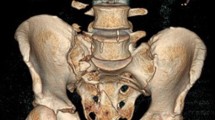Abstract
Objective
In type C pelvic ring injuries, the operative stabilization of the posterior ring is absolutely indicated. There exist four different types of operative methods: iliosacral screw fixation, transsacral plate synthesis, ventral plate fixation (primarily for sacroiliac luxations), and local plate synthesis performed on the dorsal cortex of the sacrum. In our current article, we analyzed the stability of fixation methods used together with bilateral iliolumbar techniques.
Methods
We analyzed a finite element pelvic model attached to lumbar 4–5 vertebrae. By imitating a standing position on two feet, we measured the differences in tension and displacement in T1 and T2 thoracic vertebrae fractures with and without iliolumbar fusion in cases of iliosacral screw fixation, transsacral plate synthesis and KFI-H (small fragment-H) plate synthesis.
Results
The osteosynthesises reinforced via Galveston technique were rather stable; the amount of displacement measured in the fracture gap was significantly less than in the cases without iliolumbar fusion. The tension in the implants were below the allowed values, therefore they were capable of withstanding the imposed loads without permanent deformation.
Conclusions
In unilateral pelvis injuries, if a non-weight bearing status cannot be achieved on the injured side, unilateral iliolumbar fusion reinforcement is justified, since the contralateral lower limb must also be non-weight bearing due to the pelvis injury itself. In the case of the most unstable sacrum fracture—“jumper’s fracture”, bilateral iliolumbar fusion is necessary, in which case the patient will be able to bear weight during the early postoperative period.





Similar content being viewed by others
References
Abé H, Hayashi K, Sato M (1996) Data book on mechanical properties of living cells, tissues, and organs. Springer, Tokyo
Binder JB (1995) Algor finite element modeling tools aid aerospace. Aerosp Am 33:16–18
Bodzay T, Flóris I, Váradi K (2011) Comparison of stability in the operative treatment of pelvic injuries in a finite element model. Arch Orthop Trauma Surg 10:1427–1433
Bodzay T, Szita J, Manó S, Kiss L, Jónás Z, Frenyó S, Csernátony Z (2012) Biomechanical comparison of two stabilization techniques for unstable sacral fractures. J Orthop Sci 5:574–579
Cziffer E (1997) Operatíve treatment of the fractures (in Hungarian). Springer Hungarica, Budapest, pp 417–425
Käch K, Trentz O (1994) Distraction spondylodesis of the sacrum in “vertical shear lesions” of the pelvis. Unfallchir 1:28–38
McGee AM, Bache CE, Spilsbury J, Marks DS, Stirling AJ, Thompson AG (2000) A simplified Galveston technique for the stabilization of pathological fractures of the sacrum. Eur Spine J 5:451–454
Mears DC, Capito CP, Deleuw H (1988) Posterior pelvic disruptions managed by the use of the Double Cobra Plate. Instr Course Lect 37:143–150
Pohlemann T, Angst M, Schneider E, Ganz R, Tscherne H (1993) Fixation of transforaminal sacrum fractures: a biomechanical study. J Orthop Trauma 2:107–117
Ragnarsson B, Olerud C, Olerud S (1993) Anterior square-plate fixation of sacroiliac disruption. 2–8 years follow-up of 23 consecutive cases. Acta Orthop Scand 64(2):138–142
Routt ML Jr, Meir MC, Kregor PK, Mayo KM (1993) Percutaneous iliosacral screws with the patient supine technique. Operat Tech Orthop 3:35–45
Routt ML Jr, Kregor PJ, Simonian PT, Mayo KA (1995) Early results of percutaneous iliosacral screws placed with the patient in the supine position. J Orthop Trauma 3:207–214
Schildhauer TA, Josten C, Muhr G (1998) Triangular osteosynthesis of vertically unstable sacrum fractures: a new concept allowing early weight-bearing. J Orthop Trauma 5:307–314
Schildhauer TA, Ledoux W, Chapman JR, Henley MB, Tencer AF, Routt ML Jr (2003) Triangular osteosynthesis and iliosacral screw fixation for unstable sacral fractures: a cadaveric and biomechanical evaluation under cyclic loads. J Orthop Trauma 17:22–31
Schildhauer TA, Bellabarba C, Nork SE, Barei DP, Routt ML Jr, Chapman JR (2006) Decompression and lumbopelvic fixation for sacral fracture-dislocations with spino-pelvic dissociation. J Orthop Trauma 7:447–457
Author information
Authors and Affiliations
Corresponding author
Rights and permissions
About this article
Cite this article
Bodzay, T., Sztrinkai, G., Gál, T. et al. How bilateral iliolumbar fusion increases the stability of horizontal osteosynthesis in unstable pelvic ring injuries?. Arch Orthop Trauma Surg 133, 947–952 (2013). https://doi.org/10.1007/s00402-013-1762-1
Received:
Published:
Issue Date:
DOI: https://doi.org/10.1007/s00402-013-1762-1




